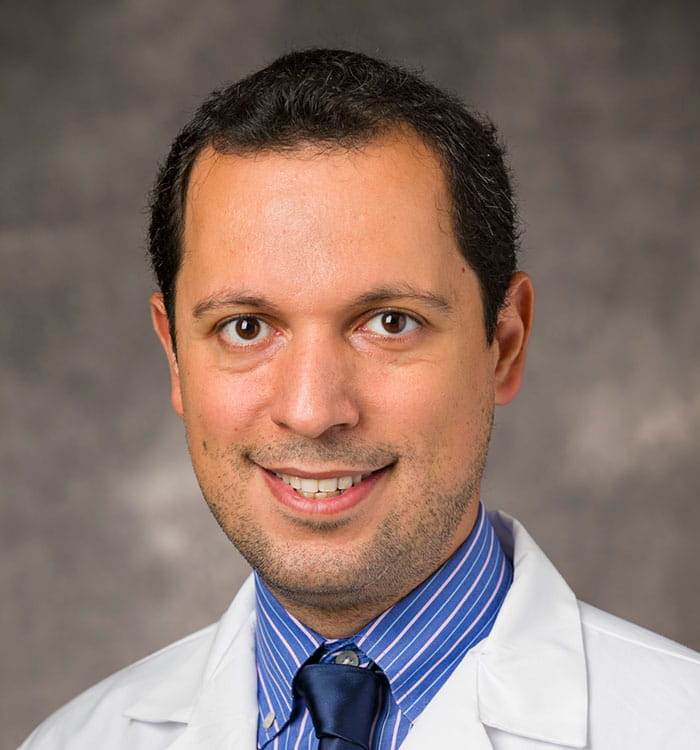Diagnosing and Managing Interstitial Lung Disease
February 09, 2019
Updates in the diagnosis and management of ILD
Innovations in Pulmonology & Sleep Medicine - Winter 2019Idiopathic pulmonary fibrosis (IPF) is the most prevalent type of Interstitial Lung Disease (ILD) and is characterized by worsening dyspnea and lung function. Many IPF patients have a history of cigarette smoking and suffer from other comorbidities. The prognosis of IPF is generally poor, so it’s an area of focused interest at University Hospitals.
 Maroun Matta, MD
Maroun Matta, MDREVISED DIAGNOSTIC GUIDELINES for Interstitial Lung Disease
“The biggest thing that happened in the field of ILD and IPF are new guidelines for diagnosing the disease,” Dr. Matta says. These new guidelines — developed by the world’s leading chest societies — were published in June 2018.There are several changes worth noting.
High-resolution scans with specific images are critical.
A regular CT scan is not sufficient for diagnosing ILD, says Dr. Matta. The new guidelines specify sequential and volumetric high-resolution CT scans, which detect even subtle abnormalities and provide precise analysis of lesion location and distribution.The guidelines also detail how physicians should obtain the scans, including multiple acquisitions in different phases of the respiratory cycle, and lower radiation doses. There are now four diagnostic categories based on scan features, as well.
“Sometimes primary care providers already ordered scans before their patients arrive in our clinic,” Dr. Matta explains. “Unfortunately, we often have to repeat the scans to get the information we need. If physicians were familiar with these guidelines, they could order the correct scans from the get-go.”
You can find a full version of the updated guidelines here.
Biopsies recommendations have changed
The panel that developed the guidelines no longer recommends for or against cryobiopsy and transbronchial biopsies, leaving the decision to perform these procedures to the discretion of individual institutions. That said, UH Cleveland Medical Center has completed its first cryobiopsy procedure, and additional patients are scheduled.“We’ve had good success with cryobiopsy so far,” Dr. Matta notes.
Furthermore, he adds, the 30-day mortality rates for cryobiopsy compared to surgical biopsy are significantly lower: 2-3.5 percent for surgery versus 1-2 percent with cryobiopsy. “This is a big advantage,” Dr. Matta says, “especially in people for whom surgery is not feasible."
Historically, transbronchial biopsies had poor sensitivity for IPF. This is changing with new technology that allows clinicians to use machine learning and genomic classifiers, Dr. Matta says. In fact, UH Cleveland Medical Center is an active site in a study to use this technology to compare surgical biopsy with cryobiopsy.
CLINICAL TRIALS UNDERWAY for ILD Treatment
UH Cleveland Medical Center is actively participating in several other important clinical trials, including a potential new treatment compound for IPF and a trial for pulmonary rehabilitation.“We know from previous studies that pulmonary rehab is a great tool to improve symptoms in patients with IPF,” says Dr. Matta. “It improves exercise capacity and reduces symptoms of dyspnea. However, it’s underutilized and is a missed opportunity.”
UH Cleveland Medical Center is recruiting patients for a three-month study to evaluate whether patients on OFEV® (nintedanib) would still benefit from pulmonary rehab in addition to their medication. Boehringer Ingelheim, the manufacturer of OFEV, is paying for patients’ rehabilitation, including the costs of transportation to and from rehab.
UH Cleveland Medical Center is also participating in a Phase II study of Celgene’s compound, CC-90001, a JNK inhibitor.
“Our understanding of the pathology of IPF is evolving,” Dr. Matta says. “We now better understand the pathology, where the injury happens and how that leads to scar tissue inside the lungs. With that evolution, new ideas for active compounds — such as CC-90001 — are emerging, targeting different pathways in pulmonary fibrosis.”
Not all trials lead to better patient care, of course. One small study explored whether combining OFEV and Esbriet® (pirfenidone), the two drugs currently approved by the U.S. Food and Drug Administration for IPF, improved outcomes. The 12-week, proof-of-concept study found that the side effects of combined therapy were high, as were the number of dropouts. For now, there are no recommendations for using both drugs in patients, Dr. Matta says.


